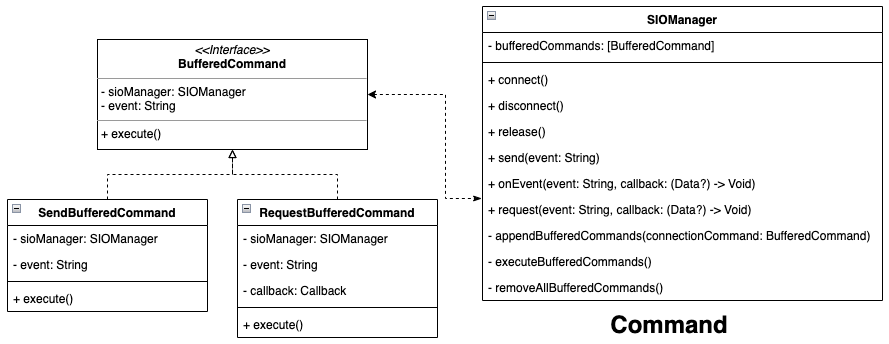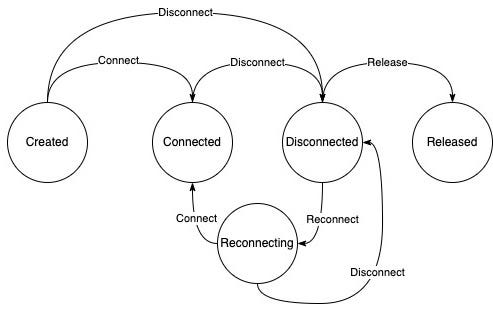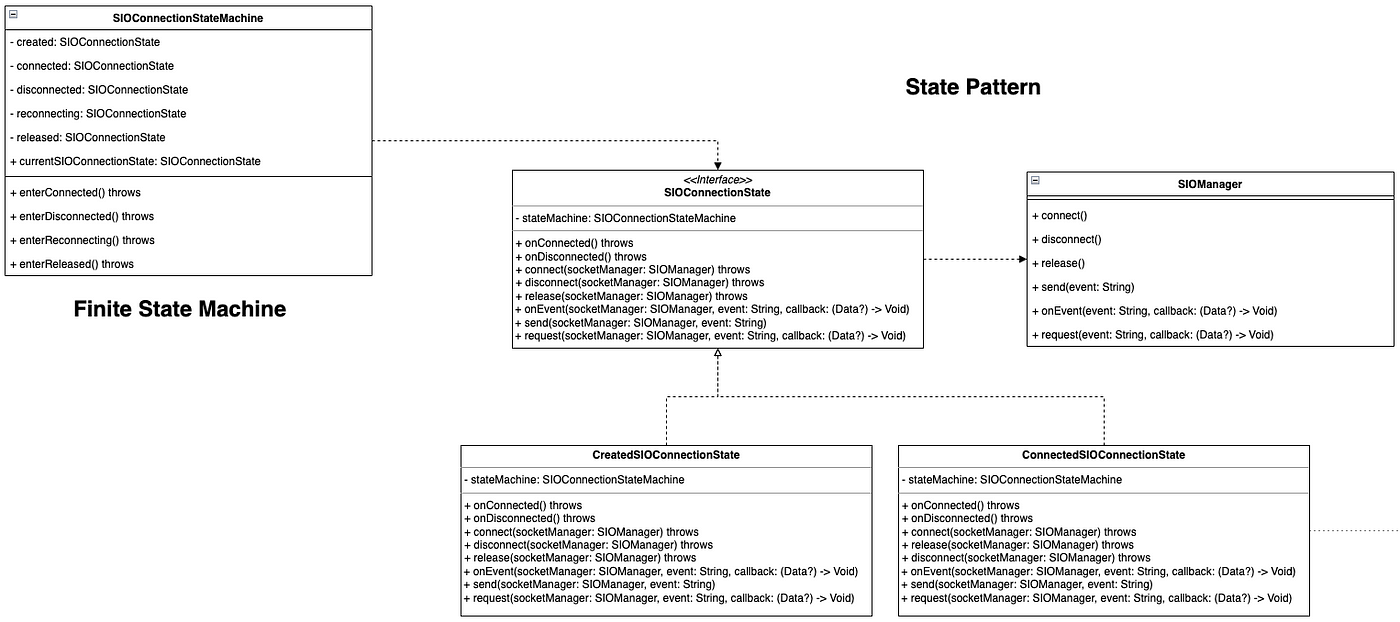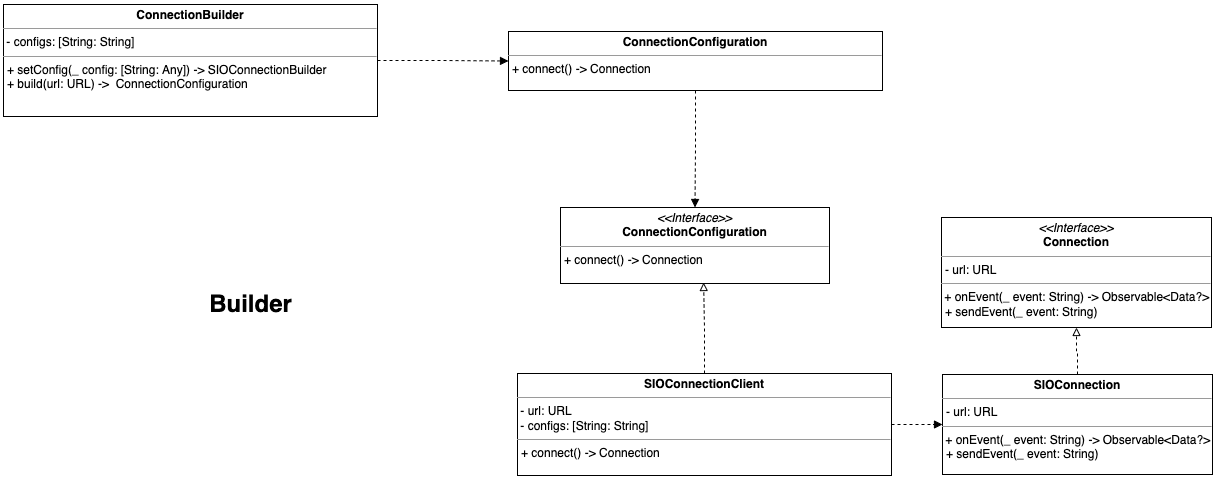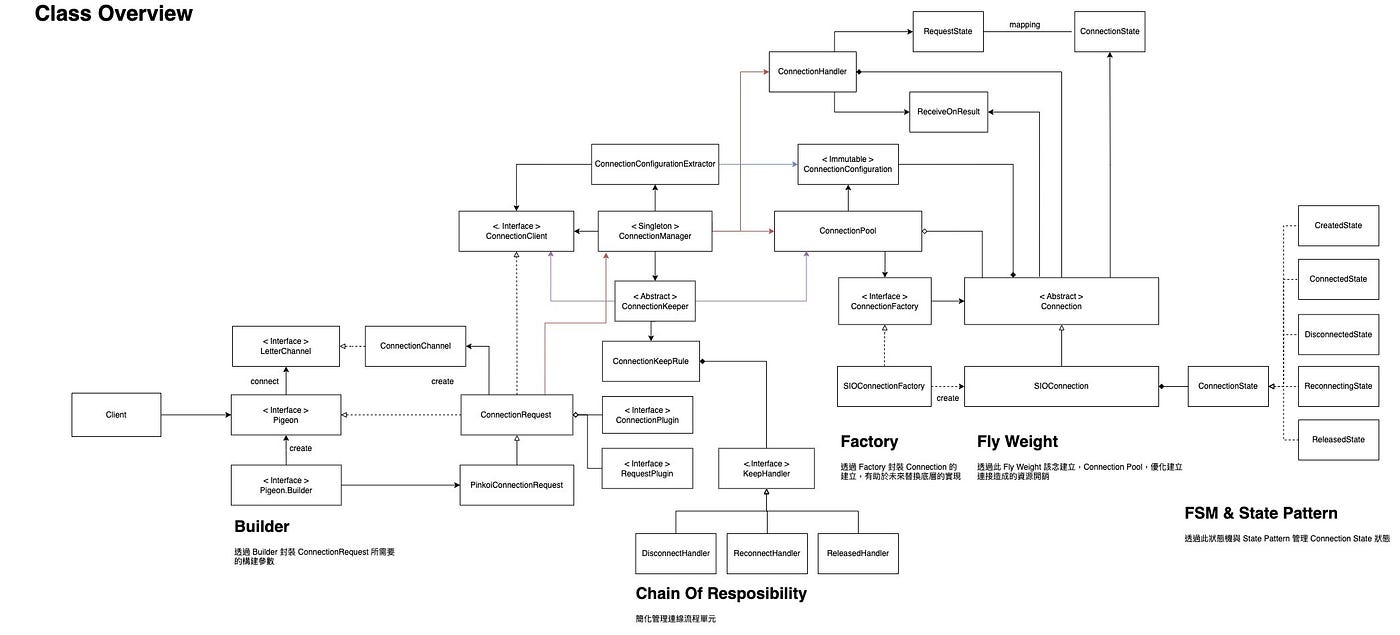Design Patterns 的實戰應用紀錄
封裝 Socket.IO Client Library 需求時遇到的問題場景及解決方法應用到的 Design Patterns
ℹ️ℹ️ℹ️ Click here to view the English version of this article, translated by OpenAI.
Design Patterns 的實戰應用紀錄
封裝 Socket.IO Client Library 需求時遇到的問題場景及解決方法應用到的 Design Patterns
Photo by Daniel McCullough
前言
此篇文章是真實的需求開發,所運用到 Design Pattern 解決問題的場景記錄;內容篇幅會涵蓋需求背景、實際遇到的問題場景 (What?)、為何要套用 Pattern 解決問題 (Why?)、實作上如何使用 (How?),建議可以從頭閱讀會比較有連貫性。
本文會介紹四個開發此需求遇到的場景及七個解決此場景的 Design Patterns 應用。
背景
組織架構
敝司於今年拆分出 Feature Teams (multiple) 與 Platform Team;前者不必多說主要負責使用者端需求、Platform Team 這邊則面對的是公司內部的成員,其中一個工作項目就是技術引入、基礎建設及做好系統性整合,為 Feature Teams 開發需求時先鋒鋪好道路。
當前需求
Feature Teams 要將原本的訊息功能 (進頁面打 API 拿訊息資料,要更新最新訊息只能重整) 改為 即時通訊 (能即時收到最新訊息、對傳訊息)。
Platform Team 工作
Platform Team 著重的點不只是當下的即時通訊需求,而是長遠的建設與複用性;評估後 webSocket 雙向通訊的機制在現代 App 中是不可或缺,除了此次的需求之外,以後也有很多機會都會用到,加上人力資源許可,故投入協助設計開發介面。
目標:
- 封裝 Pinkoi Server Side 與 Socket.IO 通訊、身份驗證邏輯
- 封裝 Socket.IO 煩瑣操作,提供基於 Pinkoi 商業需求的可擴充及方便使用介面
- 統一雙平台介面 (Socket.IO 的 Android 與 iOS Client Side Library 支援的功能及介面不相同)
- Feature 端無需了解 Socket.IO 機制
- Feature 端無需管理複雜的連線狀態
- 未來有 webSocket 雙向通訊需求能直接使用
時間及人力:
- iOS & Android 各投入一位
- 開發時程:時程 3 週
技術細節
Web & iOS & Android 三平台均會支援此 Feature;要引入 webSocket 雙向通訊協議來實現,後端預計直接使用 Socket.io 服務。
首先要說 Socket != WebSocket
關於 Socket 與 WebSocket 及技術細節可參考以下兩篇文章:
簡而言之:
1
2
Socket 是 TCP/UDP 傳輸層的抽象封裝介面,而 WebSocket 是應用層的傳輸協議。
Socket 與 WebSocket 的關係就像狗跟熱狗的關係一樣,沒有關係。
Socket.IO 是 Engine.IO 的一層抽象操作封裝,Engine.IO 則是對 WebSocket 的使用封裝,每層只負責對上對下之間的交流,不允許貫穿操作(e.g. Socket.IO 直接操作 WebSocket 連線)。
Socket.IO/Engine.IO 除了基本的 WebSocket 連線外還實做了很多方便好用的功能集合(e.g. 離線發送 Event 機制、類似 Http Request 機制、Room/Group 機制…等等)。
Platform Team 這層的主要職責是橋接 Socket.IO 與 Pinkoi Server Side 之間的邏輯,供應上層 Feature Teams 開發功能時使用。
Socket.IO Swift Client 有坑
- 已許久未更新 (最新一版還在 2019),不確定是否還有在維護。
- Client & Server Side Socket IO Version 要對齊,Server Side 可加上
{allowEIO3: true}/ 或 Client Side 指定相同版本.version否則怎麼連都連不上。 - 命名方式、介面與官網範例很多都對不起來。
- Socket.io 官網範例都是拿 Web 做介紹,實際上 Swift Client 並不一定有全支援官網寫的功能 。 此次實作發現 iOS 這邊 Library 並未實現離線發送 Event 機制 (我們是自行實現的,請往後繼續閱讀)
建議有要採用 Socket.IO 前先實驗看看你想要的機制是否支援。
Socket.IO Swift Client 是基於 Starscream WebSocket Library 的封裝,必要時可降級使用 Starscream。
1
背景資訊補充到此結束,接下來進入正題。
Design Patterns
設計模式說穿了就只是軟體設計當中常見問題的解決方案,不一定要用設計模式才能開發、設計模式不一定能適用所有場景、也沒人說不能自行歸納出新的設計模式。
The Catalog of Design Patterns
但現有的設計模式 (The 23 Gang of Four Design Patterns) 已是軟體設計中的共同知識,只要提到 XXX Pattern 大家腦中就會有相應的架構藍圖,不需多做解釋、後續維護也比較好知道脈絡、且已是經過業界驗證的方法不太需要花時間審視物件依賴問題;在適合的場景選用適合的模式可以降低溝通及維護成本,提升開發效率。
設計模式可以組合使用,但不建議對現有設計模式魔改、強行為套用而套用、套用不符合分類的 Pattern (e.g. 用責任練模式來產生物件),會失去使用的意義更可能造成後續接手的人的誤會。
本篇會提到的 Design Patterns:
- Singleton Pattern
- Flywieght Pattern
- Factory Pattern
- Command Pattern
- Finite-State Machine + State Pattern
- Chain Of Resposibility
- Builder Pattern
會逐一在後面解釋什麼場境用了、為何要用。
本文著重在 Design Pattern 的應用,而非 Socket.IO 的操作,部分示例會因為描述方便而有所刪減, 無法適用真實的 Socket.IO 封裝 。
因篇幅有限,本文不會詳細介紹每個設計模式的架構,請先點各個模式的連結進入了解該模式的架構後再繼續閱讀。
Demo Code 會使用 Swift 撰寫。
需求場景 1.
What?
- 使用相同的 Path 在不同頁面、Object 請求 Connection 時能複用取得相同的物件。
- Connection 需為抽象介面,不直接依賴 Socket.IO Object
Why?
- 減少記憶體開銷及重複連線的時間、流量成本。
- 為未來抽換成其他框架預留空間
How?
- Singleton Pattern :創建型 Pattern,保證一個物件只會有一個實體。
- Flywieght Pattern :結構型 Pattern,基於共享多個物件相同的狀態,重複使用。
- Factory Pattern :創建型 Pattern,抽象物件產生方法,使其能在外部抽換。
實際案例使用:
- Singleton Pattern:
ConnectionManager在 App Lifecycle 中僅存在一個的物件,用來管理Connection取用操作。 - Flywieght Pattern:
ConnectionPool顧名思義就是 Connection 的共用池子,統一從這個池子的方法拿出 Connection,其中邏輯就會包含當發現 URL Path 一樣時直接給予已經在池子裡的 Connection。ConnectionHandler則做為Connection的外在操作、狀態管理器。 - Factory Pattern:
ConnectionFactory搭配上面 Flywieght Pattern 當發現池子沒有可複用的Connection時則用此工廠介面去產生。
1
2
3
4
5
6
7
8
9
10
11
12
13
14
15
16
17
18
19
20
21
22
23
24
25
26
27
28
29
30
31
32
33
34
35
36
37
38
39
40
41
42
43
44
45
46
47
48
49
50
51
52
53
54
55
56
57
58
59
60
61
62
63
64
65
66
67
68
69
70
71
72
73
74
75
76
77
78
79
80
81
82
83
84
85
86
87
88
89
90
91
92
93
94
95
96
97
98
99
100
101
102
103
104
105
106
107
108
109
110
111
import Combine
import Foundation
protocol Connection {
var url: URL {get}
var id: UUID {get}
init(url: URL)
func connect()
func disconnect()
func sendEvent(_ event: String)
func onEvent(_ event: String) -> AnyPublisher<Data?, Never>
}
protocol ConnectionFactory {
func create(url: URL) -> Connection
}
class ConnectionPool {
private let connectionFactory: ConnectionFactory
private var connections: [Connection] = []
init(connectionFactory: ConnectionFactory) {
self.connectionFactory = connectionFactory
}
func getOrCreateConnection(url: URL) -> Connection {
if let connection = connections.first(where: { $0.url == url }) {
return connection
} else {
let connection = connectionFactory.create(url: url)
connections.append(connection)
return connection
}
}
}
class ConnectionHandler {
private let connection: Connection
init(connection: Connection) {
self.connection = connection
}
func getConnectionUUID() -> UUID {
return connection.id
}
}
class ConnectionManager {
static let shared = ConnectionManager(connectionPool: ConnectionPool(connectionFactory: SIOConnectionFactory()))
private let connectionPool: ConnectionPool
private init(connectionPool: ConnectionPool) {
self.connectionPool = connectionPool
}
//
func requestConnectionHandler(url: URL) -> ConnectionHandler {
let connection = connectionPool.getOrCreateConnection(url: url)
return ConnectionHandler(connection: connection)
}
}
// Socket.IO Implementation
class SIOConnection: Connection {
let url: URL
let id: UUID = UUID()
required init(url: URL) {
self.url = url
//
}
func connect() {
//
}
func disconnect() {
//
}
func sendEvent(_ event: String) {
//
}
func onEvent(_ event: String) -> AnyPublisher<Data?, Never> {
//
return PassthroughSubject<Data?, Never>().eraseToAnyPublisher()
}
}
class SIOConnectionFactory: ConnectionFactory {
func create(url: URL) -> Connection {
//
return SIOConnection(url: url)
}
}
//
print(ConnectionManager.shared.requestConnectionHandler(url: URL(string: "wss://pinkoi.com/1")!).getConnectionUUID().uuidString)
print(ConnectionManager.shared.requestConnectionHandler(url: URL(string: "wss://pinkoi.com/1")!).getConnectionUUID().uuidString)
print(ConnectionManager.shared.requestConnectionHandler(url: URL(string: "wss://pinkoi.com/2")!).getConnectionUUID().uuidString)
// output:
// D99F5429-1C6D-4EB5-A56E-9373D6F37307
// D99F5429-1C6D-4EB5-A56E-9373D6F37307
// 599CF16F-3D7C-49CF-817B-5A57C119FE31
需求場景 2.
What?
如背景技術細節所述,Socket.IO Swift Client 的 Send Event 並不支援離線發送 (但 Web/Android 版的 Library 卻可以),因此 iOS 端需要自行實現此功能。
1
神奇的是 Socket.IO Swift Client - onEvent 是支援離線訂閱的。
Why?
- 跨平台功能統一
- 程式碼容易理解
How?
- Command Pattern :行為型 Pattern,將操作包裝成對象,提供隊列、延遲、取消…等等集合操作。
- Command Pattern:
SIOManager為與 Socket.IO 溝通的最底層封裝,其中的send、request方法都是對 Socket.IO Send Event 的操作,當發現當前 Socket.IO 處於斷線狀態,則將請求參數放到bufferedCommands中,當連上之後就逐一拿出來處理 (First In First Out)。
1
2
3
4
5
6
7
8
9
10
11
12
13
14
15
16
17
18
19
20
21
22
23
24
25
26
27
28
29
30
31
32
33
34
35
36
37
38
39
40
41
42
43
44
45
46
47
48
49
50
51
52
53
54
55
56
57
58
59
60
61
62
63
64
65
66
67
68
69
70
71
72
73
74
75
76
77
78
79
80
81
82
83
84
85
86
87
88
89
90
91
92
93
94
95
96
97
98
99
100
101
102
103
104
105
106
107
108
protocol BufferedCommand {
var sioManager: SIOManagerSpec? { get set }
var event: String { get }
func execute()
}
struct SendBufferedCommand: BufferedCommand {
let event: String
weak var sioManager: SIOManagerSpec?
func execute() {
sioManager?.send(event)
}
}
struct RequestBufferedCommand: BufferedCommand {
let event: String
let callback: (Data?) -> Void
weak var sioManager: SIOManagerSpec?
func execute() {
sioManager?.request(event, callback: callback)
}
}
protocol SIOManagerSpec: AnyObject {
func connect()
func disconnect()
func onEvent(event: String, callback: @escaping (Data?) -> Void)
func send(_ event: String)
func request(_ event: String, callback: @escaping (Data?) -> Void)
}
enum ConnectionState {
case created
case connected
case disconnected
case reconnecting
case released
}
class SIOManager: SIOManagerSpec {
var state: ConnectionState = .disconnected {
didSet {
if state == .connected {
executeBufferedCommands()
}
}
}
private var bufferedCommands: [BufferedCommand] = []
func connect() {
state = .connected
}
func disconnect() {
state = .disconnected
}
func send(_ event: String) {
guard state == .connected else {
appendBufferedCommands(connectionCommand: SendBufferedCommand(event: event, sioManager: self))
return
}
print("Send:\(event)")
}
func request(_ event: String, callback: @escaping (Data?) -> Void) {
guard state == .connected else {
appendBufferedCommands(connectionCommand: RequestBufferedCommand(event: event, callback: callback, sioManager: self))
return
}
print("request:\(event)")
}
func onEvent(event: String, callback: @escaping (Data?) -> Void) {
//
}
func appendBufferedCommands(connectionCommand: BufferedCommand) {
bufferedCommands.append(connectionCommand)
}
func executeBufferedCommands() {
// First in, first out
bufferedCommands.forEach { connectionCommand in
connectionCommand.execute()
}
bufferedCommands.removeAll()
}
func removeAllBufferedCommands() {
bufferedCommands.removeAll()
}
}
let manager = SIOManager()
manager.send("send_event_1")
manager.send("send_event_2")
manager.request("request_event_1") { _ in
//
}
manager.state = .connected
同理也可以實現到 onEvent 上。
延伸:可以再套用 Proxy Pattern ,將 Buffer 功能視為一種 Proxy。
需求場景 3.
What?
Connection 有多個狀態,有序的狀態與狀態間切換、各狀態允許不同的操作。
- Created:物件被建立,允許 ->
Connected或直接進Disconnected - Connected:已連上 Socket.IO,允許 ->
Disconnected - Disconnected:已與 Socket.IO 斷線,允許 ->
Reconnectiong、Released - Reconnectiong:正在嘗試重新連上 Socket.IO,允許 ->
Connected、Disconnected - Released:物件已被標示為等待被記憶體回收,不允許任何操作及切換狀態
Why?
- 狀態與狀態的切換邏輯跟表述不容易
- 各狀態要限制操作方法(e.g. State = Released 時無法 Call Send Event),直接使用 if. .else 會讓程式難以維護閱讀
How?
- Finite State Machine :管理狀態間的切換
- State Pattern :行為型 Pattern,對象的狀態有變化時,有不同的相應處理
- Finite State Machine :
SIOConnectionStateMachine為狀態機實作,currentSIOConnectionState為當前狀態,created、connected、disconnected、reconnecting、released表列出此狀態機可能的切換狀態。enterXXXState() throws為從 Current State 進入某個狀態時的允許與不允許(throw error)實作。 - State Pattern :
SIOConnectionState為所有狀態會用到的操作方法介面抽象。
1
2
3
4
5
6
7
8
9
10
11
12
13
14
15
16
17
18
19
20
21
22
23
24
25
26
27
28
29
30
31
32
33
34
35
36
37
38
39
40
41
42
43
44
45
46
47
48
49
50
51
52
53
54
55
56
57
58
59
60
61
62
63
64
65
66
67
68
69
70
71
72
73
74
75
76
77
78
79
80
81
82
83
84
85
86
87
88
89
90
91
92
93
94
95
96
97
98
99
100
101
102
103
104
105
106
107
108
109
110
111
112
113
114
115
116
117
118
119
120
121
122
123
124
125
126
127
128
129
130
131
132
133
134
135
136
137
138
139
140
141
142
143
144
145
146
147
148
149
150
151
152
153
154
155
156
157
158
159
160
161
162
163
164
165
166
167
168
169
170
171
172
173
174
175
176
177
178
179
180
181
182
183
184
185
186
187
188
189
190
191
192
193
194
195
196
197
198
199
200
201
202
203
204
205
206
207
208
209
210
211
212
213
214
215
216
217
218
219
220
221
222
223
224
225
226
227
228
229
230
231
232
233
234
235
236
237
238
239
240
241
242
243
244
245
246
247
248
249
250
251
252
253
254
255
256
257
258
259
260
261
262
263
264
265
266
267
268
269
270
271
272
273
274
275
276
277
278
279
280
281
282
283
284
285
286
287
288
289
290
291
292
293
294
295
296
297
298
299
300
301
302
303
304
305
306
307
308
309
310
311
312
313
314
315
316
317
318
319
320
321
322
323
324
325
326
327
328
329
330
331
332
333
334
335
336
337
338
339
340
341
342
343
344
345
346
347
348
349
350
351
352
353
354
355
356
357
358
359
360
361
362
363
364
365
366
367
368
369
370
371
372
373
374
375
376
377
378
379
380
381
382
383
384
385
386
387
388
389
390
391
392
393
394
395
396
397
398
399
400
401
402
403
404
405
406
407
408
409
410
411
412
413
414
415
416
417
418
419
420
421
422
423
424
425
426
427
428
429
430
431
432
433
434
435
436
protocol SIOManagerSpec: AnyObject {
func connect()
func disconnect()
func onEvent(event: String, callback: @escaping (Data?) -> Void)
func send(_ event: String)
func request(_ event: String, callback: @escaping (Data?) -> Void)
}
enum ConnectionState {
case created
case connected
case disconnected
case reconnecting
case released
}
class SIOManager: SIOManagerSpec {
var state: ConnectionState = .disconnected {
didSet {
if state == .connected {
executeBufferedCommands()
}
}
}
private var bufferedCommands: [BufferedCommand] = []
func connect() {
state = .connected
}
func disconnect() {
state = .disconnected
}
func send(_ event: String) {
guard state == .connected else {
appendBufferedCommands(connectionCommand: SendBufferedCommand(event: event, sioManager: self))
return
}
print("Send:\(event)")
}
func request(_ event: String, callback: @escaping (Data?) -> Void) {
guard state == .connected else {
appendBufferedCommands(connectionCommand: RequestBufferedCommand(event: event, callback: callback, sioManager: self))
return
}
print("request:\(event)")
}
func onEvent(event: String, callback: @escaping (Data?) -> Void) {
//
}
func appendBufferedCommands(connectionCommand: BufferedCommand) {
bufferedCommands.append(connectionCommand)
}
func executeBufferedCommands() {
// First in, first out
bufferedCommands.forEach { connectionCommand in
connectionCommand.execute()
}
bufferedCommands.removeAll()
}
func removeAllBufferedCommands() {
bufferedCommands.removeAll()
}
}
let manager = SIOManager()
manager.send("send_event_1")
manager.send("send_event_2")
manager.request("request_event_1") { _ in
//
}
manager.state = .connected
//
class SIOConnectionStateMachine {
private(set) var currentSIOConnectionState: SIOConnectionState!
private var created: SIOConnectionState!
private var connected: SIOConnectionState!
private var disconnected: SIOConnectionState!
private var reconnecting: SIOConnectionState!
private var released: SIOConnectionState!
init() {
self.created = SIOConnectionCreatedState(stateMachine: self)
self.connected = SIOConnectionConnectedState(stateMachine: self)
self.disconnected = SIOConnectionDisconnectedState(stateMachine: self)
self.reconnecting = SIOConnectionReconnectingState(stateMachine: self)
self.released = SIOConnectionReleasedState(stateMachine: self)
self.currentSIOConnectionState = created
}
func enterConnected() throws {
if [created.connectionState, reconnecting.connectionState].contains(currentSIOConnectionState.connectionState) {
enter(connected)
} else {
throw SIOConnectionStateMachineError("\(currentSIOConnectionState.connectionState) can't enter to Connected")
}
}
func enterDisconnected() throws {
if [created.connectionState, connected.connectionState, reconnecting.connectionState].contains(currentSIOConnectionState.connectionState) {
enter(disconnected)
} else {
throw SIOConnectionStateMachineError("\(currentSIOConnectionState.connectionState) can't enter to Disconnected")
}
}
func enterReconnecting() throws {
if [disconnected.connectionState].contains(currentSIOConnectionState.connectionState) {
enter(reconnecting)
} else {
throw SIOConnectionStateMachineError("\(currentSIOConnectionState.connectionState) can't enter to Reconnecting")
}
}
func enterReleased() throws {
if [disconnected.connectionState].contains(currentSIOConnectionState.connectionState) {
enter(released)
} else {
throw SIOConnectionStateMachineError("\(currentSIOConnectionState.connectionState) can't enter to Released")
}
}
private func enter(_ state: SIOConnectionState) {
currentSIOConnectionState = state
}
}
protocol SIOConnectionState {
var connectionState: ConnectionState { get }
var stateMachine: SIOConnectionStateMachine { get }
init(stateMachine: SIOConnectionStateMachine)
func onConnected() throws
func onDisconnected() throws
func connect(socketManager: SIOManagerSpec) throws
func disconnect(socketManager: SIOManagerSpec) throws
func release(socketManager: SIOManagerSpec) throws
func request(socketManager: SIOManagerSpec, event: String, callback: @escaping (Data?) -> Void) throws
func onEvent(socketManager: SIOManagerSpec, event: String, callback: @escaping (Data?) -> Void) throws
func send(socketManager: SIOManagerSpec, event: String) throws
}
struct SIOConnectionStateMachineError: Error {
let message: String
init(_ message: String) {
self.message = message
}
var localizedDescription: String {
return message
}
}
class SIOConnectionCreatedState: SIOConnectionState {
let connectionState: ConnectionState = .created
let stateMachine: SIOConnectionStateMachine
required init(stateMachine: SIOConnectionStateMachine) {
self.stateMachine = stateMachine
}
func onConnected() throws {
try stateMachine.enterConnected()
}
func onDisconnected() throws {
try stateMachine.enterDisconnected()
}
func release(socketManager: SIOManagerSpec) throws {
throw SIOConnectionStateMachineError("ConnectedState can't release!")
}
func onEvent(socketManager: SIOManagerSpec, event: String, callback: @escaping (Data?) -> Void) throws {
// allow
// can use Helper to reduce the repeating code
// e.g. helper.XXX(socketManager: SIOManagerSpec, ....)
}
func request(socketManager: SIOManagerSpec, event: String, callback: @escaping (Data?) -> Void) throws {
// allow
// can use Helper to reduce the repeating code
// e.g. helper.XXX(socketManager: SIOManagerSpec, ....)
}
func send(socketManager: SIOManagerSpec, event: String) throws {
// allow
// can use Helper to reduce the repeating code
// e.g. helper.XXX(socketManager: SIOManagerSpec, ....)
}
func connect(socketManager: SIOManagerSpec) throws {
// allow
// can use Helper to reduce the repeating code
// e.g. helper.XXX(socketManager: SIOManagerSpec, ....)
}
func disconnect(socketManager: SIOManagerSpec) throws {
throw SIOConnectionStateMachineError("CreatedState can't disconnect!")
}
}
class SIOConnectionConnectedState: SIOConnectionState {
let connectionState: ConnectionState = .connected
let stateMachine: SIOConnectionStateMachine
required init(stateMachine: SIOConnectionStateMachine) {
self.stateMachine = stateMachine
}
func onConnected() throws {
//
}
func onDisconnected() throws {
try stateMachine.enterDisconnected()
}
func release(socketManager: SIOManagerSpec) throws {
throw SIOConnectionStateMachineError("ConnectedState can't release!")
}
func onEvent(socketManager: SIOManagerSpec, event: String, callback: @escaping (Data?) -> Void) throws {
// allow
// can use Helper to reduce the repeating code
// e.g. helper.XXX(socketManager: SIOManagerSpec, ....)
}
func request(socketManager: SIOManagerSpec, event: String, callback: @escaping (Data?) -> Void) throws {
// allow
// can use Helper to reduce the repeating code
// e.g. helper.XXX(socketManager: SIOManagerSpec, ....)
}
func send(socketManager: SIOManagerSpec, event: String) throws {
// allow
// can use Helper to reduce the repeating code
// e.g. helper.XXX(socketManager: SIOManagerSpec, ....)
}
func connect(socketManager: SIOManagerSpec) throws {
throw SIOConnectionStateMachineError("ConnectedState can't connect!")
}
func disconnect(socketManager: SIOManagerSpec) throws {
// allow
// can use Helper to reduce the repeating code
// e.g. helper.XXX(socketManager: SIOManagerSpec, ....)
}
}
class SIOConnectionDisconnectedState: SIOConnectionState {
let connectionState: ConnectionState = .disconnected
let stateMachine: SIOConnectionStateMachine
required init(stateMachine: SIOConnectionStateMachine) {
self.stateMachine = stateMachine
}
func onConnected() throws {
try stateMachine.enterConnected()
}
func onDisconnected() throws {
//
}
func release(socketManager: SIOManagerSpec) throws {
try stateMachine.enterReleased()
// allow
// can use Helper to reduce the repeating code
// e.g. helper.XXX(socketManager: SIOManagerSpec, ....)
}
func onEvent(socketManager: SIOManagerSpec, event: String, callback: @escaping (Data?) -> Void) throws {
// allow
// can use Helper to reduce the repeating code
// e.g. helper.XXX(socketManager: SIOManagerSpec, ....)
}
func request(socketManager: SIOManagerSpec, event: String, callback: @escaping (Data?) -> Void) throws {
// allow
// can use Helper to reduce the repeating code
// e.g. helper.XXX(socketManager: SIOManagerSpec, ....)
}
func send(socketManager: SIOManagerSpec, event: String) throws {
// allow
// can use Helper to reduce the repeating code
// e.g. helper.XXX(socketManager: SIOManagerSpec, ....)
}
func connect(socketManager: SIOManagerSpec) throws {
try stateMachine.enterReconnecting()
// allow
// can use Helper to reduce the repeating code
// e.g. helper.XXX(socketManager: SIOManagerSpec, ....)
}
func disconnect(socketManager: SIOManagerSpec) throws {
// allow
// can use Helper to reduce the repeating code
// e.g. helper.XXX(socketManager: SIOManagerSpec, ....)
}
}
class SIOConnectionReconnectingState: SIOConnectionState {
let connectionState: ConnectionState = .reconnecting
let stateMachine: SIOConnectionStateMachine
required init(stateMachine: SIOConnectionStateMachine) {
self.stateMachine = stateMachine
}
func onConnected() throws {
try stateMachine.enterConnected()
}
func onDisconnected() throws {
try stateMachine.enterDisconnected()
}
func release(socketManager: SIOManagerSpec) throws {
throw SIOConnectionStateMachineError("ReconnectState can't release!")
}
func onEvent(socketManager: SIOManagerSpec, event: String, callback: @escaping (Data?) -> Void) throws {
// allow
// can use Helper to reduce the repeating code
// e.g. helper.XXX(socketManager: SIOManagerSpec, ....)
}
func request(socketManager: SIOManagerSpec, event: String, callback: @escaping (Data?) -> Void) throws {
// allow
// can use Helper to reduce the repeating code
// e.g. helper.XXX(socketManager: SIOManagerSpec, ....)
}
func send(socketManager: SIOManagerSpec, event: String) throws {
// allow
// can use Helper to reduce the repeating code
// e.g. helper.XXX(socketManager: SIOManagerSpec, ....)
}
func connect(socketManager: SIOManagerSpec) throws {
throw SIOConnectionStateMachineError("ReconnectState can't connect!")
}
func disconnect(socketManager: SIOManagerSpec) throws {
// allow
// can use Helper to reduce the repeating code
// e.g. helper.XXX(socketManager: SIOManagerSpec, ....)
}
}
class SIOConnectionReleasedState: SIOConnectionState {
let connectionState: ConnectionState = .released
let stateMachine: SIOConnectionStateMachine
required init(stateMachine: SIOConnectionStateMachine) {
self.stateMachine = stateMachine
}
func onConnected() throws {
throw SIOConnectionStateMachineError("ReleasedState can't onConnected!")
}
func onDisconnected() throws {
throw SIOConnectionStateMachineError("ReleasedState can't onDisconnected!")
}
func release(socketManager: SIOManagerSpec) throws {
throw SIOConnectionStateMachineError("ReleasedState can't release!")
}
func request(socketManager: SIOManagerSpec, event: String, callback: @escaping (Data?) -> Void) throws {
throw SIOConnectionStateMachineError("ReleasedState can't request!")
}
func onEvent(socketManager: SIOManagerSpec, event: String, callback: @escaping (Data?) -> Void) throws {
throw SIOConnectionStateMachineError("ReleasedState can't receiveOn!")
}
func send(socketManager: SIOManagerSpec, event: String) throws {
throw SIOConnectionStateMachineError("ReleasedState can't send!")
}
func connect(socketManager: SIOManagerSpec) throws {
throw SIOConnectionStateMachineError("ReleasedState can't connect!")
}
func disconnect(socketManager: SIOManagerSpec) throws {
throw SIOConnectionStateMachineError("ReleasedState can't disconnect!")
}
}
do {
let stateMachine = SIOConnectionStateMachine()
// mock on socket.io connect:
// socketIO.on(connect){
try stateMachine.currentSIOConnectionState.onConnected()
try stateMachine.currentSIOConnectionState.send(socketManager: manager, event: "test")
try stateMachine.currentSIOConnectionState.release(socketManager: manager)
try stateMachine.currentSIOConnectionState.send(socketManager: manager, event: "test")
// }
} catch {
print("error: \(error)")
}
// output:
// error: SIOConnectionStateMachineError(message: "ConnectedState can\'t release!")
需求場景 3.
What?
結合場景 1. 2.,有了 ConnectionPool 享元池子加上 State Pattern 狀態管理後;我們繼續往下延伸,如背景目標所述,Feature 端不需去管背後 Connection 的連線機制;因此我們建立了一個輪詢器 (命名為 ConnectionKeeper ) 會定時掃描 ConnectionPool 中強持有的 Connection ,並在發生以下狀況時做操作:
Connection有人在使用且狀態非Connected:將狀態改為Reconnecting並嘗試重新連線Connection已無人使用且狀態為Connected:將狀態改為DisconnectedConnection已無人使用且狀態為Disconnected:將狀態改為Released並從ConnectionPool中移除
Why?
- 三個操作有上下關係且互斥 (disconnected -> released or reconnecting)
- 可彈性抽換、增加狀況操作
- 未封裝的話只能將三個判斷及操作直接寫在方法中 (難以測試其中邏輯)
- e.g:
1
2
3
4
5
6
7
if !connection.isOccupie() && connection.state == .connected then
... connection.disconnected()
else if !connection.isOccupie() && state == .released then
... connection.release()
else if connection.isOccupie() && state == .disconnected then
... connection.reconnecting()
end
How?
- Chain Of Resposibility :行為型 Pattern,顧名思義是一條鏈,每個節點都有相應的操作,輸入資料後節點可決定是否要操作還是丟給下一個節點處理,另一個現實應用是 iOS Responder Chain 。
照定義 Chain of responsibility Pattern 是不允許某個節點已經接下處理資料,但處理完又丟給下一個節點繼續處理, 要做就做完,不然不要做 。
如果是上述場景比較適合的應該是 Interceptor Pattern 。
- Chain of responsibility:
ConnectionKeeperHandler為鍊的節點抽象,特別抽出canExcute方法避免發生上述 這個節點接下來處理了,但做完又想呼叫後面的節點繼續執行的狀況、handle為鍊的節點串連、excute為要處理的話會怎麼處理的邏輯。ConnectionKeeperHandlerContext用來存放會用到的資料,isOccupie代表 Connection 有無人在使用。
1
2
3
4
5
6
7
8
9
10
11
12
13
14
15
16
17
18
19
20
21
22
23
24
25
26
27
28
29
30
31
32
33
34
35
36
37
38
39
40
41
42
43
44
45
46
47
48
49
50
51
52
53
54
55
56
57
58
59
60
61
62
63
64
65
66
67
68
69
70
71
72
73
74
75
76
77
78
79
80
81
82
83
84
85
86
87
88
89
90
91
92
93
94
95
96
97
98
99
100
101
102
103
104
105
106
107
108
109
110
111
112
113
114
115
116
117
118
119
120
121
122
123
124
125
126
127
128
129
130
131
132
133
enum ConnectionState {
case created
case connected
case disconnected
case reconnecting
case released
}
protocol Connection {
var connectionState: ConnectionState {get}
var url: URL {get}
var id: UUID {get}
init(url: URL)
func connect()
func reconnect()
func disconnect()
func sendEvent(_ event: String)
func onEvent(_ event: String) -> AnyPublisher<Data?, Never>
}
// Socket.IO Implementation
class SIOConnection: Connection {
let connectionState: ConnectionState = .created
let url: URL
let id: UUID = UUID()
required init(url: URL) {
self.url = url
//
}
func connect() {
//
}
func disconnect() {
//
}
func reconnect() {
//
}
func sendEvent(_ event: String) {
//
}
func onEvent(_ event: String) -> AnyPublisher<Data?, Never> {
//
return PassthroughSubject<Data?, Never>().eraseToAnyPublisher()
}
}
//
struct ConnectionKeeperHandlerContext {
let connection: Connection
let isOccupie: Bool
}
protocol ConnectionKeeperHandler {
var nextHandler: ConnectionKeeperHandler? { get set }
func handle(context: ConnectionKeeperHandlerContext)
func execute(context: ConnectionKeeperHandlerContext)
func canExcute(context: ConnectionKeeperHandlerContext) -> Bool
}
extension ConnectionKeeperHandler {
func handle(context: ConnectionKeeperHandlerContext) {
if canExcute(context: context) {
execute(context: context)
} else {
nextHandler?.handle(context: context)
}
}
}
class DisconnectedConnectionKeeperHandler: ConnectionKeeperHandler {
var nextHandler: ConnectionKeeperHandler?
func execute(context: ConnectionKeeperHandlerContext) {
context.connection.disconnect()
}
func canExcute(context: ConnectionKeeperHandlerContext) -> Bool {
if context.connection.connectionState == .connected && !context.isOccupie {
return true
}
return false
}
}
class ReconnectConnectionKeeperHandler: ConnectionKeeperHandler {
var nextHandler: ConnectionKeeperHandler?
func execute(context: ConnectionKeeperHandlerContext) {
context.connection.reconnect()
}
func canExcute(context: ConnectionKeeperHandlerContext) -> Bool {
if context.connection.connectionState == .disconnected && context.isOccupie {
return true
}
return false
}
}
class ReleasedConnectionKeeperHandler: ConnectionKeeperHandler {
var nextHandler: ConnectionKeeperHandler?
func execute(context: ConnectionKeeperHandlerContext) {
context.connection.disconnect()
}
func canExcute(context: ConnectionKeeperHandlerContext) -> Bool {
if context.connection.connectionState == .disconnected && !context.isOccupie {
return true
}
return false
}
}
let connection = SIOConnection(url: URL(string: "wss://pinkoi.com")!)
let disconnectedHandler = DisconnectedConnectionKeeperHandler()
let reconnectHandler = ReconnectConnectionKeeperHandler()
let releasedHandler = ReleasedConnectionKeeperHandler()
disconnectedHandler.nextHandler = reconnectHandler
reconnectHandler.nextHandler = releasedHandler
disconnectedHandler.handle(context: ConnectionKeeperHandlerContext(connection: connection, isOccupie: false))
需求場景 4.
What?
我們封裝出的 Connection 需要經過 setup 後才能使用,例如給予 URL Path、設定 Config…等等
Why?
- 可以彈性的增減構建開口
- 可複用構建邏輯
- 未封裝的話,外部可以不照預期操作類別
- e.g.:
1
2
3
4
5
6
7
8
❌
let connection = Connection()
connection.send(event) // unexpected method call, should call .connect() first
✅
let connection = Connection()
connection.connect()
connection.send(event)
// but...who knows???
How?
- Builder Pattern :創建型 Pattern,能夠分步驟構建對象及複用構建方法。
- Builder Pattern:
SIOConnectionBuilder為Connection的構建器,負責設定、存放構建Connection時會用到的資料;ConnectionConfiguration抽象介面用來保證要使用Connection前必須呼叫.connect()才能拿到Connection實體。
1
2
3
4
5
6
7
8
9
10
11
12
13
14
15
16
17
18
19
20
21
22
23
24
25
26
27
28
29
30
31
32
33
34
35
36
37
38
39
40
41
42
43
44
45
46
47
48
49
50
51
52
53
54
55
56
57
58
59
60
61
62
63
64
65
66
67
68
69
70
71
72
73
74
75
76
77
78
79
80
81
82
83
84
85
86
87
88
89
90
91
92
93
94
95
enum ConnectionState {
case created
case connected
case disconnected
case reconnecting
case released
}
protocol Connection {
var connectionState: ConnectionState {get}
var url: URL {get}
var id: UUID {get}
init(url: URL)
func connect()
func reconnect()
func disconnect()
func sendEvent(_ event: String)
func onEvent(_ event: String) -> AnyPublisher<Data?, Never>
}
// Socket.IO Implementation
class SIOConnection: Connection {
let connectionState: ConnectionState = .created
let url: URL
let id: UUID = UUID()
required init(url: URL) {
self.url = url
//
}
func connect() {
//
}
func disconnect() {
//
}
func reconnect() {
//
}
func sendEvent(_ event: String) {
//
}
func onEvent(_ event: String) -> AnyPublisher<Data?, Never> {
//
return PassthroughSubject<Data?, Never>().eraseToAnyPublisher()
}
}
//
class SIOConnectionClient: ConnectionConfiguration {
private let url: URL
private let config: [String: Any]
init(url: URL, config: [String: Any]) {
self.url = url
self.config = config
}
func connect() -> Connection {
// set config
return SIOConnection(url: url)
}
}
protocol ConnectionConfiguration {
func connect() -> Connection
}
class SIOConnectionBuilder {
private(set) var config: [String: Any] = [:]
func setConfig(_ config: [String: Any]) -> SIOConnectionBuilder {
self.config = config
return self
}
// url is required parameter
func build(url: URL) -> ConnectionConfiguration {
return SIOConnectionClient(url: url, config: self.config)
}
}
let builder = SIOConnectionBuilder().setConfig(["test":123])
let connection1 = builder.build(url: URL(string: "wss://pinkoi.com/1")!).connect()
let connection2 = builder.build(url: URL(string: "wss://pinkoi.com/1")!).connect()
延伸:這裏也可以再套用 Factory Pattern ,將用工廠產出 SIOConnection 。
完結!
以上就是本次封裝 Socket.IO 中遇到的四個場景及七個使用到解決問題的 Design Patterns。
最後附上此次封裝 Socket.IO 的完整設計藍圖
與文中命名、示範略為不同,這張圖才是真實的設計架構;有機會再請原設計者分享設計理念及開源。
Who?
誰做了這些設計跟負責 Socket.IO 封裝專案呢?
Sean Zheng , Android Engineer @ Pinkoi
主要架構設計者、Design Pattern 評估套用、在 Android 端使用 Kotlin 實現設計。
ZhgChgLi , Enginner Lead/iOS Enginner @ Pinkoi
Platform Team 專案負責人、Pair programming、在 iOS 端使用 Swift 實現設計、討論並提出質疑(a.k.a. 出一張嘴)及最後撰寫本文與大家分享。
延伸閱讀
- Design Patterns 的實戰應用紀錄 — In WKWebView with Builder, Strategy & Chain of Responsibility Pattern
- Visitor Pattern in Swift (Share Object to XXX Example)
- Visitor Pattern in TableView
有任何問題及指教歡迎 與我聯絡 。
本文首次發表於 Medium ➡️ 前往查看
由 ZMediumToMarkdown 與 Medium-to-jekyll-starter 提供自動轉換與同步技術。

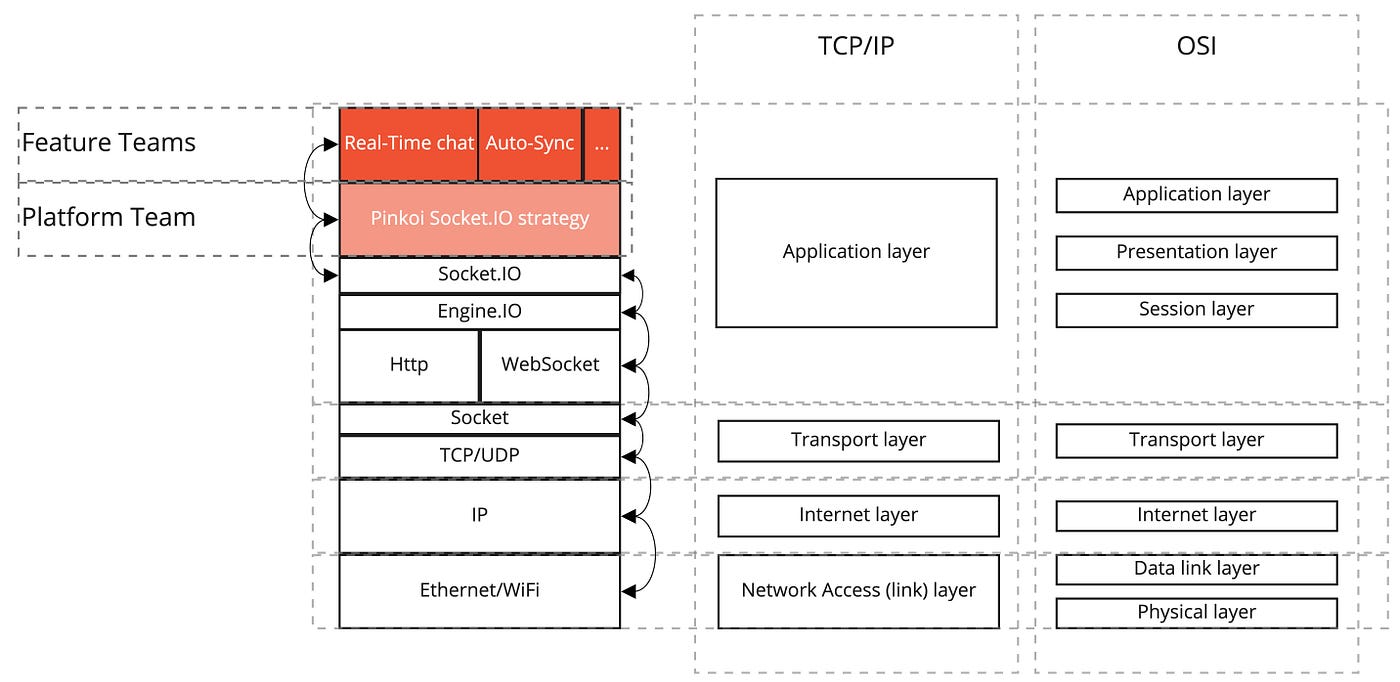
{:target="_blank"}](/assets/78507a8de6a5/1*MAm5WPynbv7M9tdmW2lNGQ.jpeg)

